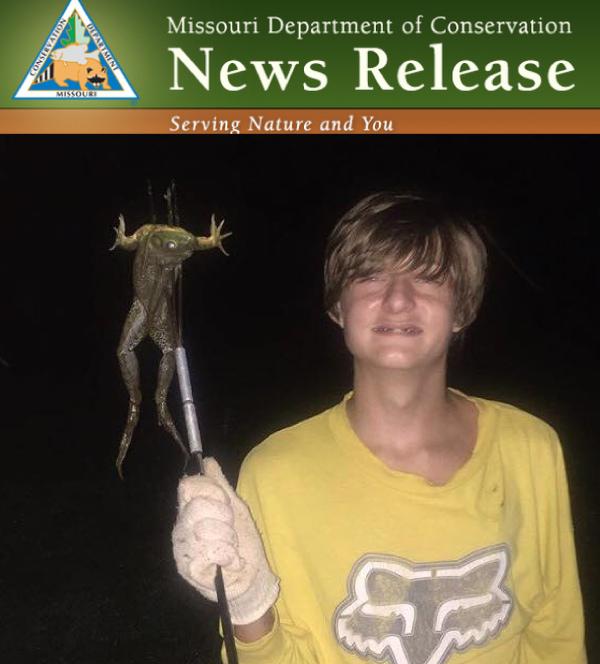
O'Fallon, Missouri - The Missouri Department of Conservation (MDC) reports that James Lucas of O’Fallon became the most recent record-breaking angler in Missouri when he caught a hybrid striped bass on the Mississippi River.
The new “alternative method” record hybrid striped bass caught by Lucas on April 22 weighed 8-pounds, 6-ounces with a length of 24 3/4 inches and a girth of 18 1/2 inches. Lucas caught the fish with a throwline in one of his honey holes. MDC staff verified the record-weight fish using a certified scale in O’Fallon.
“I’m really excited that I caught this fish,” said Lucas. “I have been trying for over a month and a half to set this record with a throwline, and I’m just really glad all my practice finally paid off.”
Lucas added fishing with a throwline isn’t easy; it takes a lot of practice to get it down.
“I was able to locate the fish and get over the hybrid striped bass and drop my line. Then the fight was on. The striped bass put up a decent fight, but once I got him on the bank, I got that gut feeling I had the record,” he said. “I didn’t know for sure until I talked with MDC and they confirmed it.”
Lucas is familiar with state-record fish. He holds a state record for the skipjack herring in the alternative method category, which he broke on April 8.
“You haven’t heard the last of me,” he said. “I hope to set many more state records in the future. As for this fish, I plan on mounting it and putting it on the wall with the others.”
Missouri state-record fish are recognized in two categories: pole-and-line and alternative methods. Alternative methods include: throwlines, trotlines, limb lines, bank lines, jug lines, spearfishing, snagging, snaring, gigging, grabbing, archery, and atlatl.

After six and half years, Ziehmer is stepping down as director effective July 15.
Jefferson City, Missouri - The Missouri Department of Conservation (MDC) announces that Director Robert L. Ziehmer is stepping down as director effective July 15, 2016.
“It is with mixed emotions that I am resigning from my position as director,” Ziehmer said. “My decision to leave was not easy. The many years I have spent with the Department have been both professionally challenging and rewarding. However, I am excited about continuing my conservation career through a new endeavor in the private sector.”
Ziehmer has been with MDC for over 25 years. During his last six and half years as director, he has continued to move conservation forward by forging strong statewide and national conservation partnerships and increasing public engagement on key conservation initiatives.
Some milestones during Ziehmer’s tenure include restoration activities for elk, prairie chickens, hellbenders and sturgeon; active efforts to deliver the conservation message in all public schools; implementation of major infrastructure projects, including hatchery renovations, wetland renovations, shooting range renovations, and new regional facilities; working to improve the agency’s business processes; and continuing MDC’s role as a national leader in fish, forest, and wildlife management.
“Bob’s dedication to Missouri Conservation and his career with the Department has made a lasting impact for the betterment of the fish, forest, and wildlife of this state,” said Conservation Commission Chair Marilynn Bradford. “He has chosen to take the next step in his conservation career, and we are indebted to he and his family for his devoted service and commitment to Missouri Conservation.”
Ziehmer was appointed director in January 2010. He is the 8th person to serve in this capacity since MDC’s founding in 1937.

Congratulations to Colby Conn on breaking the state record by catching a 1-pound, 5-ounce white crappie with a trotline on Stockton Lake.
Dade County, Missouri - The Missouri Department of Conservation (MDC) reports Colby Conn of Everton became the most recent record-breaking angler in Missouri when he hooked a white crappie on Stockton Lake on a trotline. The new “alternative method” record fish caught by Conn on May 21 weighed 1-pound, 5-ounces with a length of 14 5/16 inches. Conn’s recent catch broke the previous state-record of a 12-ounce white crappie caught on a trotline in 1993.
“Once I pulled the fish up into the boat, I had feeling that the crappie was going to be a state record,” Conn said. “I was super stoked!”
Conn was using goldfish for bait to try to catch catfish, but instead he caught the record crappie. MDC staff verified the fish using a certified scale in the town of Greenfield.
Once MDC gave him confirmation he had a state record, Conn said he was in shock. “This year was the first year I have ever put out trotlines, and out of nowhere I catch a state-record white crappie. I really can’t believe it,” he said. “I would love to break another state record in the future, but I am fine with just having this one.”
Conn added he plans on having the state-record white crappie mounted.
“2016 is shaping up to be a year for state-record fish,” said MDC Fisheries Programs Specialist Andrew Branson. “We have already had 13 new records so far, which is more than we see in an entire year sometimes. The mild weather we have had this year means more anglers are fishing, and catching big fish.”
Missouri state-record fish are recognized in two categories: pole-and-line and alternative methods. Alternative methods include: throwlines, trotlines, limb lines, bank lines, jug lines, spearfishing, snagging, snaring, gigging, grabbing, archery, and atlatl.

Missouri - Austin Jones, a 13-year old student at Richland R-1 Schools, knows all to well the pride in frogging in Missouri. He is the son of Carlie & Cody Jones. He's counting the days until Frogging season opens!!
The Missouri Department of Conservation (MDC) encourages Missourians to discover nature this summer -- and one fun and exciting way is through frogging. Frogging season begins June 30 at sunset and ends Oct. 31. Missouri has two frog species that are legal game — bullfrog and green frog. Bullfrogs are larger and therefore more sought-after.
The daily limit is eight frogs of both species combined and the possession limit is 16 frogs of both species combined. Only the daily limit may be possessed on the waters or banks thereof where limits apply. Daily limits end at midnight so froggers who catch their daily limits before midnight and then want to return for more frogging after midnight must remove the daily limit of previously caught frogs from the waters or banks before returning for more.
Frogging can be done with either a fishing permit or a small-game hunting permit. Children under the age of 16 and Missouri residents 65 years of age or older are not required to have a permit. Those with a fishing permit may take frogs by hand, hand net, atlatl, gig, bow, trotline, throw line, limb line, bank line, jug line, snagging, snaring, grabbing or pole and line. With a small game hunting permit, frogs may be harvested using a .22-caliber or smaller rimfire rifle or pistol, pellet gun, atlatl, bow, crossbow, or by hand or hand net. The use of an artificial light is permitted when frogging.

Last year, hunters checked 166,383 deer during the 2014 November portion of firearms deer season with 78,556 being antlered bucks, 19,300 being button bucks, and 68,527 being does.
"Good weather and plenty of deer activity likely are the reasons why there was an increase in deer harvest during the November portion of the firearms deer season this year," MDC Deer Biologist Jason Sumners said.
MDC reported five firearms-related hunting incidents during the fall firearms November portion. The five incidents involved self-inflicted firearm wounds and occurred in Butler (2), Franklin, Newton, and Howard counties.
Deer hunting in Missouri continues with archery deer hunting from Nov. 25 through Jan. 15, firearms antlerless portion Nov. 25 through Dec. 6, firearms alternative methods portion Dec. 19-29, and firearms late youth portion Jan. 2-3.
Missouri offers some of the best deer hunting in the country and deer hunting is an important part of many Missourians' lives and family traditions. Deer hunting is also an important economic driver in Missouri and gives a $1 billion annual boost to the state and local economies.

